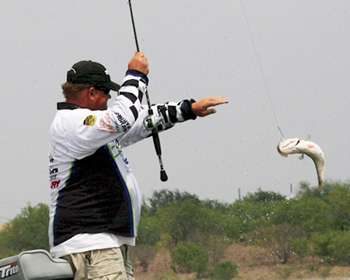
The dreaded cold front — nothing can take the shine off hopes for the next day's fishing like hearing the weatherman utter those words on the nightly news. However, depending on the time of the year, a cold front can be a blessing.
To Elite Series pro Kenyon Hill, the first strong cold front of fall is a welcome occurrence, as he knows that shortly after its arrival the fishing will be on the upswing.
"Cold fronts during the fall seem to affect bass a lot less than they do during the spring," he says. "I think it's because in the spring their metabolism isn't as high as it is during the fall."
Cold fronts in the fall typically spell an end to the summertime patterns, which can often lead to difficult prospecting if you're after quantity. As the water cools during and after the front's passing, baitfish begin migrating to shallow pockets. Bass are quickly in pursuit, feeding for the impending winter.
"A strong cold front in the fall is going to start cooling the water temperatures down and moving the bait up shallower," Hill explains. "Immediately after the front passes, you're going to have to start slowing down your presentation."
The Oklahoma pro points out that shad-frenzied bass will still be susceptible to the same techniques as they were prior to the cold front's arrival, but they will likely be somewhat lethargic immediately after the front passes. "They tend to shy away from topwater immediately after the front passes because of the drop in water temperature," he says.
"A few days following the front, after the water temperatures have settled down a bit, things can really get kicked off. I usually view that first cold front as the true arrival of a fall pattern."
While shad die off in colder water throughout the winter, the first cold front of the fall season has little impact on them — aside from grouping them tighter in the shallower water, where sunlight penetration is greatest.
"Usually, that first big cold front will start pulling the shad into the backs of pockets and into tight groups," Hill says. "That makes the bass a little more accessible and, usually, a little easier to pattern."
After the first major cold front, Hill begins targeting shallow pockets where baitfish congregate. "You'll start to see little schools of shad in the backs of these pockets quickly after the front," he points out. "That's a pretty easy pattern to develop immediately following a strong cold front because it's going to get everything kicked off."
Hill cautions that following a fall cold front, bass can get finicky about chasing anything that's not the same size as the shad they're pursuing. "Sometimes it's going to be difficult to match a small crankbait, which is what I like to use as a search tool this time of the year, to the size of shad bass are keying on," he says. "A Carolina rig with a baby Fluke on the end can be a good alternative."
In spring, a cold front that drops water temperatures a degree or two can have a severe, detrimental impact on fishing. But Hill explains that this is not generally the case in the fall. "In order for it to have a big impact, water temperatures need to drop at least 4 to 6 degrees," he says.
"Anything less is just not going to be that noticeable to the fish this time of the year."




